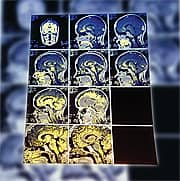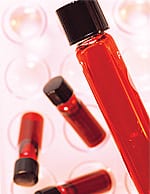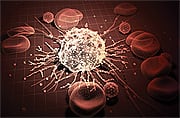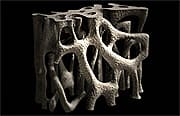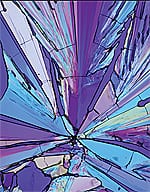Life Extension Magazine®
We are shocked and surprised at the untimely deaths of celebrities, such as Tim Russert. And we all know someone who seemed to be the picture of health but suddenly died or developed a serious, fatal illness. Yet every one of these tragedies could have been prevented if the victim only knew that they were suffering from a silent disease. The truth is that disease is rarely silent, and illness is rarely isolated. In fact, most illnesses quietly begin an avalanche of health problems. As we get older, one or more of our organs will start to fail before we are even aware of it. You may have found your first gray hairs, or have had a momentary lapse when trying to remember a phone number or someone’s name. These clues aren’t really the first signs of aging: by the time they occur, you’re already well into the process. Inside your body greater changes have already started, and may be affecting your health in a number of ways. For example, if you are diagnosed with diabetes, your elevated sugar levels are also damaging your blood circulation, your kidneys, your skin, your eyes, your heart, and even the neurons of your brain. These issues used to be considered as “independent yet related symptoms of disease or comorbidity.” But they all comprise the body’s aging code. The key to prolonging good health and continuing to lead a vibrant and active life is the ability to identify the aging parts of your body that may already be experiencing the ravages of silent diseases, and treating them at the earliest possible opportunity. By doing so, you are literally reversing the aging process by breaking the aging code. The goal is to intimately know your health status so that you can predict and prevent all forms of silent disease, including heart disease, cancer, osteoporosis, and diabetes. The single most effective way to do this is by combining early diagnosis with preventive anti-aging treatment. The New Annual Check-UpMany diseases are asymptomatic, or silent, until they have progressed to their advanced stages.1-3 For example, Alzheimer’s disease doesn’t occur overnight.4 Just like heart disease, it’s a condition that begins slowly and silently and progresses over the years. That’s why a proactive approach to health care begins with a thorough annual check-up. This is critically important, especially if you do not have any medical symptoms or conditions Yet, an annual examination not only allows you the peace of mind knowing that you are in excellent health, it also creates a health baseline so that you can compare your exam results year after year. Physicians are not trained to think of aging as the first stage of disease. Even enlightened doctors are unlikely to detect some of the most aggressive silent diseases via a regular physical exam. In my office, annual exams feature diagnostic testing that can pinpoint the aging code of every organ in the body, so I can take care of my patients by treating their oldest parts first. With these tools, most silent diseases can be detected early—and early detection allows for early treatment. Talk to Your Doctor About These Testing Options:
The Point of Prevention
So many health care professionals still focus on treating disease once it is diagnosed. They’re still not getting the big picture and miss 90% of silent disease. While early detection is key, prevention is equally important in guaranteeing a longer, healthier life. By focusing on preventive treatment, my patients don’t experience unexpected illnesses or surprise deaths. Preventing Heart Attack and StrokeWe can now conclusively predict who is most likely to become the victim of a stroke or heart attack, even though the majority of patients who die of a sudden heart attack have few or no symptoms.13,14 For example, a major study of 28,000 women at Boston’s Brigham and Women’s Hospital provided conclusive evidence that painless inflammation of heart and blood vessels is a major trigger of heart attacks—even more so than high cholesterol. Women with high levels of inflammation are twice as likely as those with high cholesterol to die from heart attacks and strokes.13 The collective condition known as “cardiovascular disease” refers to disorders of the heart as well as the vascular system: the internal network of blood vessels through which the heart pushes blood. Be on the lookout for these signs and symptoms, and if they occur, talk to your doctor immediately. A C-reactive protein blood test is one of the simplest ways to identify chronic inflammation that may be smoldering in your body. Coronary computed tomography angiography (CTA) is another useful technique for identifying heart disease risk and may replace stress thallium and angiogram test. Signs and Symptoms of Heart Attack
Signs and Symptoms of Stroke
Your Waistline Predicts Your Heart HealthYou can never start a cardiovascular program soon enough. In assessing your heart attack risk, simply look at the notches on your belt buckle. An increasing waistline measurement is a reliable risk indicator of heart disease.15 Comprehensive annual blood testing is most important, along with ankle-brachial index and carotid ultrasound testing in higher-risk individuals. While no tests are foolproof, these tests greatly improve your odds of catching heart or cardiovascular disease in the early stages and preventing premature death. Bioidentical HormonesPotential heart disease patients may benefit from preventive hormone therapy, especially testosterone therapy (in men).16,17 Testosterone and other hormones strengthen the heart muscle, which will aid in heart contraction and improve the heart’s pumping ability. DHEA may help protect against atherosclerosis and cardiovascular disease.18,19 A report from JAMA suggests that the hormone erythropoietin may have a beneficial impact on chronic congestive heart failure.20 It helps prevent inflammation, and studies show it can prevent cell injury and maintain cell integrity. Erythropoietin may improve blood flow to ischemic cells starved of oxygen and nutrients, decreasing the amount of neuronal damage. Drugs such as Procrit® as well as beta-2-agonists such as fenoterol21 can increase erythropoietin concentrations in humans. Natural Supplements For a Younger HeartTo prevent and treat heart disease, I recommend a variety of supplements, including:
Dietary Modifications For a Healthy HeartBy following a healthy lifestyle including exercise and a diet rich in fruits, vegetables, healthy whole grains, and plenty of low-fat protein, you may lose some of the extra weight that can contribute to heart disease. You also need to eat foods that are low in sodium, which will naturally reduce internal swelling and water retention. Eggs used to be off-limits because of their high cholesterol content. However, eggs do not significantly raise blood cholesterol levels when consumed as part of a healthy and conscientious dietary plan.39 Better still, they are a perfect protein source because they are rich in amino acids, increasing your feeling of fullness so that you won’t overeat. Soy is another important food source you can focus on. When used as a part of a low-fat, low-cholesterol diet, soy lowers your total cholesterol and LDL levels without changing your HDL levels.40 Preventing CancerEvery organ of the body can become cancerous, including bones and skin. Cancer can be compared to an autoimmune response in which good cells are “turned” bad, which then multiply and invade both organs and entire systems of the body. These bad cells represent cancer. Cancer can also be considered as a condition of immune dysfunction/suppression, in which cancer cells escape immune surveillance, invading the body.
While it is difficult for you to predict whether or not you will have cancer, there are certain universalities that you can become familiar with. Many in the medical community now believe that infections may be one cause of cancer. Some evidence suggests that milder antibiotics used to treat low-grade infections (such as doxycycline) could play a role in preventing cancer.41 This relationship shows why it is so important to protect your immune system: not just for fighting infection, but for modulating your overall risk for cancer. Like almost every other disease group, cancer seems to favor individuals who are obese, sleep-deprived, depressed, or suffer from brain chemical imbalances. Some cancers are mostly related to genetic factors, and others are activated by lifestyle and the environment. The classic environmental cancer was first associated with chimney sweeps. These men were heavily exposed to carbon and charcoal and developed testicular cancer. Today we still have environmental cancers of all types, and avoiding environmental carcinogens is an important part of a cancer-prevention strategy. The following pollutants have been directly associated with cancer:
Catch Cancers EarlyThere are many types of tests that can effectively identify early cancers. I believe that a combination of the positron emission tomography (PET) scan, blood tests, ultrasound, and magnetic resonance imaging (MRI) can find virtually every type of cancer. To my mind, three images can break the cancer code: a PET scan lights up with hypermetabolic activity; the MRI gives more detail of anatomy; and an ultrasound gives a good first-pass assessment of all nodules, lumps, and bumps. Ultimately, a great cancer exam is a head-to-toe ultrasound with all the blood testing markers. It’s also important to get periodic heavy metal testing and appropriate cancer screening if you are at high risk due to genetic or environmental factors. Bioidentical Hormones and CancerIt is now well established that most of our hormone levels decrease with aging, while cancer risk increases with age.53,54 Many people getting cancer have low detectable hormone levels. While the main cause of cancer is aging, not natural hormone loss, restoring youthful hormone levels using bioidentical hormone replacement therapy may confer life-enhancing benefits for older adults.
Nutrients That Prevent CancerIncreasing your vitamin D intake may help lower the risk of breast, colon, skin, prostate, and ovarian cancer by as much as 50%, according to a recent article in The American Journal of Public Health.55 You should also check your multivitamin for its iron content. Iron is necessary for the body’s functioning, but too much iron can be lethal, since excess iron can be associated with heart disease and increased malignancy.56,57 Controlling inflammation and oxidative stress may play an even greater role in cancer prevention.58 Anti-inflammatory and antioxidant supplements that may help protect against cancer include curcumin, green tea, and gamma tocopherol.59-62 Preventing Osteoporosis
Osteoporosis refers to loss of bone density leading to weakening of the bones. Bone is living tissue that is composed of a soft, porous center encased in a hard outer surface. Osteoporosis occurs when bones lose their strength and density, become fragile, weak, and brittle due to calcium loss, and the bone literally collapses on itself. When this occurs, the bones throughout the body—but primarily within the spinal column—begin to weaken. Any change in your height or bone deterioration is considered abnormal, and certainly nothing that you should just “live with.” Your aging bones are affected by a host of variables, including hormone loss, vitamins, and minerals, as well as age, weight, drug use, and genetics. Yet your future does not have to include a hip fracture, because osteoporosis and osteopenia are preventable and reversible. Bioidentical Hormones For Younger Bones
Foods and Nutrients Support Healthy Bones
You need to eat plenty of calcium-rich food to keep your bones strong. But did you know that some of the healthiest food choices may be working against you? A diet that is too high in animal protein washes calcium out of your blood so your bones don’t get the chance to absorb this important nutrient. A purely vegetarian, high-fiber diet isn’t the answer either. Too much fiber and not enough protein can bind important nutrients so that they are excreted before they get absorbed. Fruits, vegetables, beans, nuts, and seeds may contain anti-inflammatory phytochemicals; certain vegetables, beans and nuts, and fish are fairly good sources of calcium, and dairy products are rich in calcium. You also need to choose foods that support bone growth, which include foods that are high in magnesium, calcium, potassium, and vitamins K and D. Leafy green vegetables such as kale, collard greens, bok choy, parsley, mustard greens, and escarole are good sources of calcium, magnesium, and vitamin K. Tofu (if produced with a calcium-based coagulant), chickpeas, black-eyed peas, other legumes, most nuts, and many grains are also fairly good sources of calcium. Acidic foods such as lemon juice and vinegar help the body absorb calcium. Omega-3 essential fatty acids (found in fish oil and flax oil) increase calcium absorption from the gut, reduce urinary calcium excretion, increase calcium deposits in bone, and improve bone strength.63
| |||||||||||||||||||||||||||||
Preventing DiabetesDiabetes is probably the easiest of the silent diseases for you to predict. A sedentary lifestyle paired with excess weight and the overconsumption of high-glycemic-index foods is a recipe for disaster that can lead to Type II diabetes. Careful monitoring of your weight and your food choices will help you prevent diabetes. Focus on lean proteins at each meal, and restrict your sugar and starch intake. You also need to choose fiber-rich whole grains to release glucose in a steady stream to moderate blood sugar levels. Good food choices include:
Dietary supplements such as chromium, cinnamon, and alpha-amylase inhibitors (such as white kidney bean extract) may also help promote healthy blood sugar levels.64,65 Optimal levels of DHEA and testosterone also help support healthy blood sugar control.66,67
Am I Diabetic?Diabetes is easily confirmed by measuring your blood glucose levels. A more accurate measurement of underlying glucose impairment is the hemo-globin A1C blood test. But be on the look out for these symptoms:
ConclusionEven if you feel vibrant and healthy, disease processes like heart disease, cancer, osteoporosis, and diabetes may be silently underway, threatening to rob you of your future health. The key to living a long life unencumbered by disease is to identify aging parts of your body that may be experiencing decline before disease strikes and then take action to treat them. This can be accomplished with comprehensive annual check-ups that include advanced screening methods and thorough blood testing. By taking action early utilizing an integrative program of healthy diet, targeted nutrients, bioidentical hormones, and prescription therapies (as needed), you can ensure a bright healthy future free from the silent diseases that rob aging adults of their healthful vigor. If you have any questions on the scientific content of this article, please call a Life Extension Health Advisor at 1-800-226-2370. About Eric R. Braverman, MDDr. Eric Braverman is director of PATH Medical and the clinical assistant professor of neurological surgery at New York Presbyterian Hospital/Weill Cornell Medical Center in the Department of Neurosurgery. He has conducted extensive research in anti-aging medicine and in brain trauma and health. He is the author of several bestselling books, including The Edge Effect (Sterling, 2005); Younger You (McGraw-Hill, 2008); and most recently, The Younger (Thinner) You Diet (Rodale, 2008).
| ||||||||||||||||||||||||||||||||||||||
| References | ||||||||||||||||||||||||||||||||||||||
| 1. S Afr Med J. 1996 Sep;86(9):1113-6. 2. J Am Coll Cardiol. 2006 Jan 3;47(1):65-71. 3. Srp Arh Celok Lek. 2005 Jan;133(1-2):72-5. 4. Acta Neurol Scand Suppl. 1996;165:63-71. 5. BMC Psychiatry. 2008;889. 6. Front Neurol Neurosci. 2009;24:39-46. 7. Alzheimers Dement. 2008 Jan;4(1 Suppl 1):S137-43. 8. Int J Psychophysiol. 2008 Apr;68(1):75-80. 9. J Clin Neurophysiol. 2006 Oct;23(5):456-61. 10. Clin Neurophysiol. 2008 Jun;119(6):1232-41. 11. Schizophr Bull. 2007 Jul;33(4):955-70. 12. J Neuropsychiatry Clin Neurosci. 2006;18(4):460-500. 13. Ann Intern Med. 2002 Apr 2;136(7):529-33. 14. www.womensheart.org/content/HeartAttack/heart_attack_symptoms_risks.asp. 15. Presse Med. 2008 Oct;37(10):1407-14. 16. Front Horm Res. 2009;37:91-107. 17. BioDrugs. 1998 May;9(5):351-62. 18. Endocr J. 2008 Aug;55(4):667-75. 19. Circulation. 2006 Oct 24;114(17):1829-37. 20. JAMA. 2005 Jan 5;293(1):90-5. 21. Br J Clin Pharmacol. 1998;45:157-9. 22. Br J Biomed Sci. 2000;57(4):273-80. 23. CNS Neurosci Ther. 2008;14(4):287-94. 24. Nutr Metab Cardiovasc Dis. 2008 Dec;18(10):691-9. 25. J Mol Cell Cardiol. 2008 May;44(5):927-37. 26. Am Fam Physician. 2007 Aug 15;76(4):549-56. 27. Klin Med (Mosk). 2008;86(9):64-7. 28. Am J Physiol Heart Circ Physiol. 2008 May;294(5):H1971-7. 29. Proc Nutr Soc. 2008 May;67(2):232-7. 30. Clin Drug Investig. 2005;25(11):701-7. 31. Altern Med Rev. 2002 Jun;7(3):203-17. 32. Arch Intern Med. 2008 Jun 9;168(11):1174-80. 33. IUBMB Life. 2008 Jun;60(6):355-61. 34. J Rheumatol. 2008 Mar;35(3):407-13. 35. Eur J Clin Nutr. 1988 Nov;42(11):939-44. 36. Clin Nutr. 2004 Jun;23(3):423-33. 37. Lipids Health Dis. 2008;712. 38. Am J Ther. 2007 Mar;14(2):203-12. 39. Eur J Nutr. 2008 Sep;47(6):287-93. 40. J Nutr. 2004 Sep;134(9):2395-400. 41. Zhonghua Bing Li Xue Za Zhi. 2006 Nov;35(11):677-80. 42. Rev Environ Health. 2008 Oct;23(4):243-97. 43. J Cancer Res Clin Oncol. 1983;105(2):183-8. 44. Drugs Today (Barc). 2005 Jan;41(1):37-53. 45. Rev Mal Respir. 2009 Apr;26(4):413-21. 46. Cancer Detect.Prev. 1998;22(6):533-9. 47. Int Arch Occup Environ Health. 2007 Aug;80(8):679-88. 48. Tex Rep Biol Med. 1973;31(4):715-26. 49. Int J Cancer. 2007 Jan 15;120(2):406-10. 50. Environ Sci Technol. 2007 Jan 15;41(2):363-72. 51. Can Nurse. 2007 Jan;103(1):22-6. 52. Cancer Causes Control. 2006 May;17(4):421-8. 53. Br J Gen Pract. 2007 May;57(538):404-6. 54. Folia Med (Plovdiv). 2009 Jan;51(1):15-22. 55. Am J Public Health. 2006 Feb;96(2):252-61. 56. Can J Cardiol. 2009 Apr;25(4):213-8. 57. Cancer Sci. 2009 Jan;100(1):9-16. 58. Recent Pat Inflamm Allergy Drug Discov. 2009;3(1):73-80. 59. Antioxid Redox Signal. 2008 Mar;10(3):475-510. 60. Cancer Res. 2008 Sep 15;68(18):7428-38. 61. Molecules. 2007;12(5):946-57. 62. FASEB J. 2002 Dec;16(14):1952-4. 63. Altern Med Rev. 2001 Feb;6(1):61-77. 64. J Am Coll Nutr. 1998 Dec;17(6):548-55. 65. Med Hypotheses. 2005;64(1):151-8. 66. Diabetes Care. 2009 Mar 16. 67. Am J Physiol Endocrinol Metab. 2007 Dec;293(6):E1465-78. |


